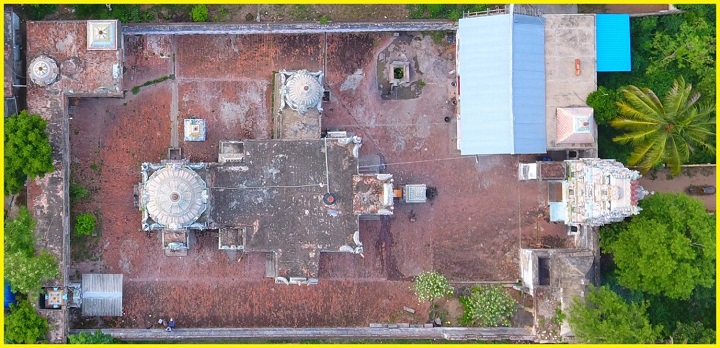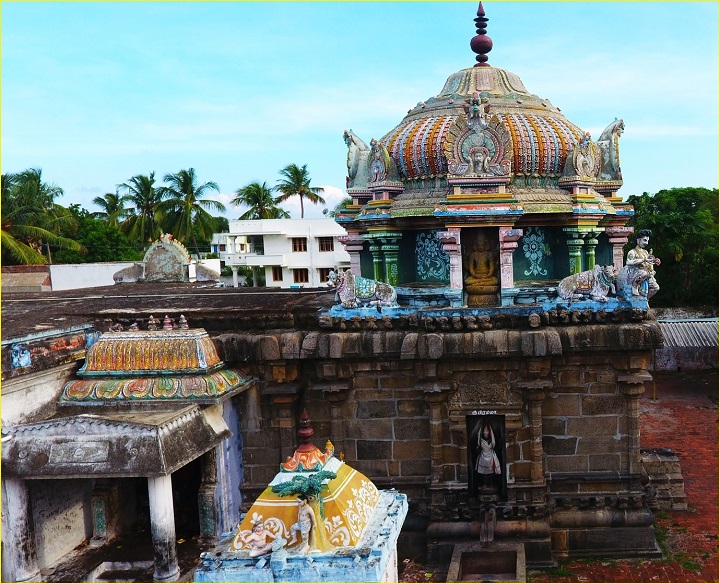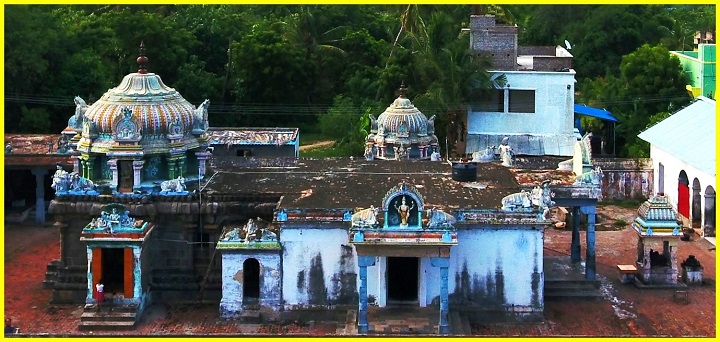 |
 |
 |
http://www.varalaaru.com A Monthly Web Magazine for South Asian History [186 Issues] [1832 Articles] |
 |
 |
 |
http://www.varalaaru.com A Monthly Web Magazine for South Asian History [186 Issues] [1832 Articles] |
|
Issue No. 149

இதழ் 149 [ மே 2020 ] 
இந்த இதழில்.. In this Issue.. 
|
Thirukkazhippalai and Sivapuri are small villages lying in the Chidambaram block of Cuddalore is about 5 kms from south east of Chidambaram. Presently the Palaivananatha Swami temple is relocated and reconstructed in Sivapuri is about 100 years back according to the information gathered from elderly persons belonging to the Thirukkazhippalai village. Originally the temple was on the bank of river Colorone. The temple is known for its unique architecture, the main shrine is a Misra vimana (Nagara Adi tala, Diravida Griva and Vesara Sikara). The presiding deity of the temple is Palaivananatha Swami and the goddess is Vedanayaki. The PalaivananathaSwamy temple of the Thirukkazhippalai Temple consists of a vimana, a mukha mandapa, a maha mandapa, an open pillared mandapa and an entrance gopura encompassed by fort-wall all the four sides. The vimana and the mukha mandapa are the earliest among them, constructed by the Parantaka 1.
 (An Arial view of the whole temple complex) THE VIMANA It is an Aranga vimana, a single tier nagara adi tala, dravida griva and vesara shikara structure with an adhishthana, bhitti, prastara, griva, sikhara and stupi. The vimana is sectioned as karna-bhadra-karna divisions with slight projection of the bhadra on all sides whereas the karna sections are simply demarcated with a plain wall and a pilaster in the corner.  Pratibandha adhishthana ,upana, jagati, rudra kumuda and yazhi series forms the components of adhishthana. The yazhis in the prati series are excellent workmanship; yazhis paired facing each other with their mouth wide open revealing their sharp canines, orderly shown manes, and sharp clawed limbs are special to mention. Above the pradivari vedika complex formed padas flanked by Kampas. The corners are adorned with makaras, a soldier is shown emerging from its mouth by wide opening. The prati series is followed by upari kampa. Little inside the upari kampa raises the wall cantoned by Vishnukantha pilasters. The pilasters possess a square base above which raises the vishnukantha shaft and the upper ornamentation of the pilasters are mala, sthana, kattu, kalasa, tadi, kumbha, padma pali, phalaka and the virakantha. In the mala section each facet of the vishnukantha pilaster is adorned with either flower festoons inside the beaded garland or leafy creeper ornamentations and in some places dancing damsels. In the sthana either circular scrolls or creepy scrolls are shown, inside each circle a blossom is shown. Embossed ornamentation is shown for the kalasa, tadi and kumbha, but the ornamentations in some of the pilasters are not well formed. between the square base and the mala Padma kattu shown upwards and downwards. The potikas above the pilasters are angular taranga with kulavu, the kulavu is seen in both the angular section and bottom. Besides, the potikas also have median patta. The potikas that are resting above the corner pilasters are four limbed whereas in the middle they are three limbed.  The valabhi is adorned with bhuta series. The roof of the tala extend as flexed over hanging kapota which are rimmed at the edges. The kapota with kudus above the plasters, corner pattas are shown and chandra mandalas in the rims. The tala ends with bhumi desa. As like the prati series, the yazhi frieze in the bhumidesa and in the corner the makaras, soldiers are shown emerging out of it. In the bhadra divisions, koshthas are seen in the middle on the west, north and south housing the deities Lingodbhavar, Bramma and Dhaksinamurthy respectively. The koshthas are flanked by rudrakantha split pilasters that carry the same features of the pilasters of the bhitti exept the Padma kattu in the middle. The niches are crowned with makara thorana. The makara thoranas on the north, west and the south are well formed with varied ornamentations. (To be Cond.) |

சிறப்பிதழ்கள் Special Issues 

புகைப்படத் தொகுப்பு Photo Gallery 
|
| (C) 2004, varalaaru.com. All articles are copyrighted to respective authors. Unauthorized reproduction of any article, image or audio/video contents published here, without the prior approval of the authors or varalaaru.com are strictly prohibited. | ||